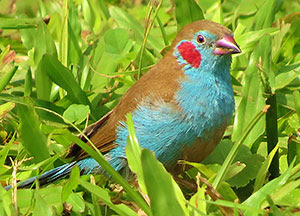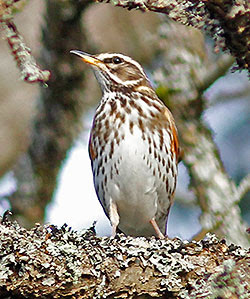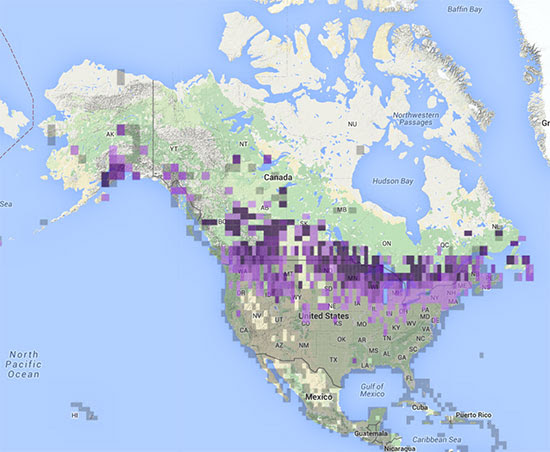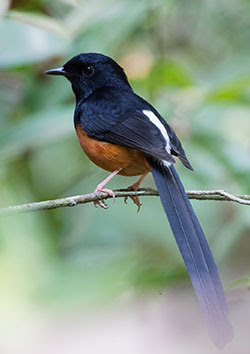GBBC 2016 Halftime Report
by Marshall Iliff, Cornell Lab of Ornithology, for eBird/GBBC
February 14, 2016
 |
| Red-cheeked Cordonbleu by Veena Naik, Uganda, 2016 GBBC. |
Overview
Wow, the 2016 Great Backyard Bird Count is going strong! Thanks to all of you who have been out counting birds around the word, despite the wacky weather in some parts of North America—sub-zero temperatures in the Northeast and an abnormal blast of heat along the West Coast.
As of midday on Sunday, February 14, (Eastern U.S. time zone) we have received checklists from about 110 countries, including Australia, Kuwait, Iceland, India, South Africa, Thailand, Malaysia, the Philippines, Turkey, and many more. Below are the top 10 countries by number of checklists submitted along with their species tallies. Click on the country name to get the very latest totals in our “Explore a Region” tool. A “plus” sign means the number is higher than last year at this time, a “minus” sign means it’s lower. An asterisk means this country has cracked the top 10 for the first time–at least for now! (Note that the numbers will likely have changed a bit by the time you read this.)
Last year participants tallied about 50% of the world’s bird species and we’re wondering if we might top that this year! You can keep counting all the way through Monday, February 15.
Exciting Rare Birds
Birds have wings and the planet is always changing. One of the greatest thrills of conducting bird censuses like the GBBC—or eBird year round—is the chance of finding a bird that “shouldn’t be there.” In fact many of these rare bird appearances are messages from Mother Earth, indicative of larger-scale phenomena occurring on our planet. This year’s count has been no exception as rare and unusual species are making headlines across North America and around the world.
We are all familiar with American Robin, but how many of us are familiar with its rarer relatives in the charismatic genus Turdus that sometimes in the border regions? This year’s GBBC may have the best diversity ever for Turdus in the U.S. and Canada with four special robin relatives so far on the count: a couple rare White-throated Thrushes from Mexico moved across the border to south Texas and one near McAllen, Texas, has been documented on this year’s count—this species was first found in the U.S. in 1990 and has only been found in a handful of years ever since. Clay-colored Thrush—the national bird of Costa Rica—has been expanding northward and has recently consolidated its foothold in Texas, where it is now a scarce resident; several have been found during the GBBC. West Mexico has contributed too, sending a Rufous-backed Robin to Catalina State Park in Arizona, superbly photographed on Friday.
 |
| Redwing by Marie O’Shaughnessy, British Columbia, 2016 GBBC. |
Hailing from across the pond in Europe, a Redwinghas been especially exciting in Nova Scotia—they turn up a couple times a decade in Atlantic Canada. Even more impressive, British Columbia’s second-ever Redwing probably came from the other direction—crossing the North Pacific from Siberia—and has been a sensation ever since its discovery in mid-December and a first British Columbia record for the species during the GBBC.
El Niño may take credit for the British Columbia bird, thanks to its pattern of storm tracks across the north Pacific. But El Niño’s Atlantic sister—the North Atlantic Oscillation (NAO)—is a similar water temperature anomaly that is entering a negative phase and its pattern of easterly winds and their avian passengers may be the explanation for the Nova Scotia Redwing.
Longer-term patterns associated with climate are also apparent. Even as coastal areas are more at risk from rising oceans, the conditions for breeding geese in Greenland get ever better as melting ice sheets give way to tundra and ponds appropriate for nesting. European-wintering Barnacle Geese are one of the benefactors and vagrant records to Atlantic Canada and the Northeast U.S. have been on the rise for the last couple decades. With this GBBC, the City of Brotherly Love has been graced by a pair of Barnacle Geese, providing a county first. These birds were first found the day before the count but have been widely enjoyed by Philly GBBCers this weekend.
Warming climate is also driving northward expansions in many species, and U.S. birders get especially excited by Mexican species that cross the border. Highlights so far from the 2016 GBBC include a long-staying Northern Jacana in Texas, two Black-capped Gnatcatchers in southeast Arizona, a Streak-backed Oriole in Yuma, Arizona, and two fancy seed-eaters in south Texas: Crimson-collared Grosbeak and Blue Bunting. The gnatcatcher—along with certain other Mexican species—has recently been increasing and consolidating its foothold in the U.S.
 |
| Oriental Honey-buzzard by Mick Jerram, Australia, 2016 GBBC. |
Elsewhere in the world, Taiwan birders have been lucky to host a Nordmann’s Greenshank—a globally rare shorebird similar to the Greater Yellowlegs familiar to North American birders. In Panama, aWhite-faced Ibis in Gamboa marks the species number 1,002 recorded from that small but diverse country.
Down Under in Australia, Oriental Honey-buzzards have made the national hotlines and have been counted for the GBBC, including the photo at the left and others uploaded to the checklist from the first day of the count. Congrats to the lucky Aussies who have ticked these special raptors, which prey on the larvae of bees and wasps!
Winter Irruptives Not On the Move
Tracking the movement of winter irruptive species is always one of the most fun patterns to look into on the GBBC. This year, like last year, has been a fairly average one. Not many finches or owls have invaded far south of their Canadian homes. But with so much data coming in from across North America, we can see some cool shifts in where they are being reported.
Common Redpoll is a northern finch that specializes in birch and alder catkins, and really loves nyjer seed at bird feeders. In 2015 they did not come very far south, but were pretty common in the Northeast and Atlantic Canada. In 2016 the population seems to have shifted into the Northwest. (See maps below.) To what extent this shift from 2015 to 2016 results from eastern birds moving west, as opposed to higher breeding success in the East and West respectively, is one of the questions that is still poorly understood with redpolls. Data from efforts like the GBBC help to paint a clearer picture.
2015 Common Redpoll Reports

2016 Common Redpoll Reports

Compare the two maps’ intensity for southern Quebec, New Brunswick, and Maine (common in 2015) to British Columbia and Alberta (where redpolls are more prevalent in 2016).
Snowy Owl frequency maps look almost identical between the two years as well: compare the2015 map to the map for 2016. For a species like Snowy Owl with such variability from year to year, such similarity between years is almost the exception rather than the rule.
 |
| White-rumped Shama by Shivashankar Manjunatha, India, 2016 GBBC. |
International highlights
Once again, India has been a lot of fun to watch during the GBBC! Indian birders have been abuzz on Facebook and other social media and currently hold the highest species count worldwide—633 species is 35 species higher than at this time last year and exceeds the current U.S. total by 20! With 3,083 complete checklists, India trails behind only Canada for number of species and ranks third in the world for participation.
In Australia, 487 species have been found over these past 2 days. Several of the top submitters have had more than 100 species. With more than 1,081 checklists so far from around the continent, and another full day to go, it will be thrilling to see how high Australia can climb.
Species totals in Canada are just barely behind last year (222 this year vs. 228 species last year), but still have some time to brave the chill and eke out a few more species. Canada’s “Tropics” are in British Columbia, where the Pacific Ocean moderates the temperatures west of the Rockies. As usual its species total is the highest—with 181 so far. Ontario is second highest in species total, notching 115 so far, but is dominating the participation statistics with an amazing showing of 2,010 checklists—almost 43% of the Canadian total.
Reporting complete checklists is important in the GBBC, since it not only tells us where birds are, but also where birds are not. We need a special award for the toughest GBBCer on the planet who has submitted two checklists from Nunavut—Canada’s northernmost and most frozen province. Let’s all wish good luck to Brian Zadawski, whose single species surveys have done a great job documenting the species that aren’t there: obviously the smart and healthy birds migrate south during the Arctic winter! Without looking, can you guess what species he has found on both of his surveys so far?
Birders in Mexico have surely been more comfortable as they have tallied 532 species on 338 checklists, already ahead of last year on species and doubling their participation stats. Mexico is home to more than 100 endemic species—birds found nowhere else—so our global species total will depend on Mexican birders hunting down some of their specialties, many of which occur in very localized patches of special habitat in the country.
It has been fun to see Réunion, a small Indian Ocean nation, join the GBBC family for the first time. Raphaël Nussbaumer has submitted three counts from the island and has found 18 species, including a few—like the Reunion Harrier and Reunion Gray White-eye—that have never been found on a GBBC before! Thanks Raphaël!
Réunion is just one of more than 110 countries reporting so far. Sudan, São Tomé and Príncipe,Laos, and the Faroe Islands are just a few of the fun countries to see participating this year. High species totals and record participation from South Africa (371), Brazil (355), and Thailand (304) are helping to drive the global species tally upwards. Taiwan, Costa Rica, and tiny Serbia again are taking honorable mentions for participation, all showing up in the top 10 so far. Serbia is seven species ahead of last year’s half-time tally—keep it up! Try exploring yourself to see what others are seeing around the world.
Are You Counting Your Feeder Birds Correctly?
 |
| Purple Finches and American Goldfinches by Kenneth Vanourney, Kentucky, 2016 GBBC. |
Much birding during the GBBC comes from backyards where counters watch birds at their feeders. Bird feeders provide crucial food resources during wintertime when natural food can be scarce, and as a result yards with good bird feeder set-ups can have some of the best bird concentrations around, even in urban and suburban habitats. However, it can be really challenging. If you participate in Project Feederwatch be sure to read our story on how to count your feeder birds for the GBBC and eBbird because the counting protocol is somewhat different. Most importantly, please make sure to estimate the total number of birds, not the total number of visits. If one bird comes to your feeder a hundred times, make sure not to count it as 100 birds!
- Explore what’s being reported with the “Explore a Location” tool. You can see what species are being reported and how many checklists are being turned in at the county, state/province, and country levels. Just click “Explore Data” on the GBBC or eBird websites and you’ll see the “Explore a Location” tool at the top of the list.
- Turn your GBBC observations into a work of art–add some photos to your checklists.See our “How to” instructions.
- Go to eBird.org and try making a Targets list for your county or state in February. This may show what species are around that you have not yet reported. Click “map” to see where to find those birds and perhaps you’ll get to see and report them for the GBBC.
- Submit photos for the GBBC photo contest or just explore some of the fantastic images that are coming in!
Thank you for participating in the Great Backyard Bird Count!
|